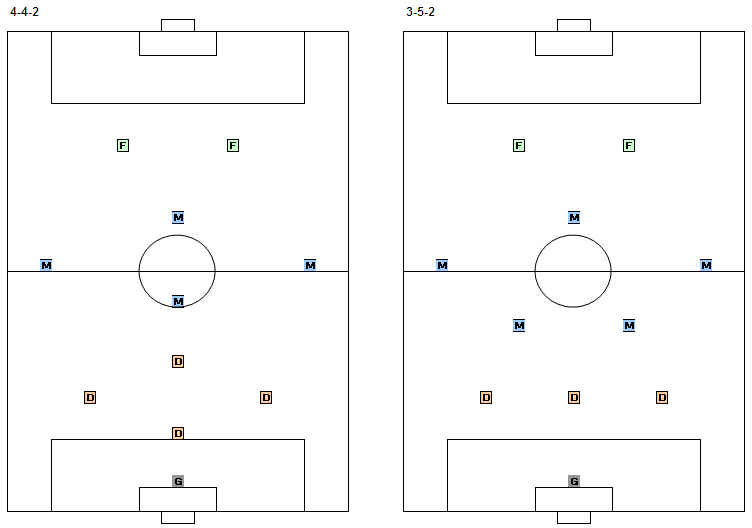| Why I like the 3-5-2 | ||
| deepbrook home | back to portfolio | back to soccer home | ||
|
At one level, formations in soccer don't matter a lot given the fluidity of the game. At another level, however, they communicate a philosophy. I'll compare the 3-5-2 (3 defenders, 5 midfielders, 2 strikers) the 4-4-2 (4 defenders, 4 midfielders, 2 strikers), which in my humble opinion is the only other formation worth seriously considering. The major advantage of the 3-5-2 is the more even spacing that it provides, and the more emphasis on midfield holding. The figure below helps to illustrate. 
But the image above is just a static snap shot. What does the 3-5-2 mean with respect to the run of play? Starting from the back: Defense The center back is responsible for the first attacker up the middle who isn't picked up by one of the defensive midfielders, and for providing cover back to the corners behind the two wing backs. The center back needs to be a good communicator, which means more than yelling at midfielders to get back. When outnumbered, the center back needs to help whatever defense can be mustered to make the right cover decisions. The wing backs cover the first attackers into their respective areas. Since most opponents will run 2 strikers, one of the wing backs (or the center back) will be covering a midfielder. In either case, once the attackers are within reasonable striking distance of the goal, the defenders should be playing man-to-man. The offsides trap: to be or not to be? I'm in favor of moderate use of the trap. The absolute key is the weak-side (opposite the ball) wing back. It is imperative that the wing back stay even with the center back, or else communicate to the center back not to play the trap at that particular moment. Specifically, the wing back needs to be ready to push up the field hard if the center back pushes up to create the trap. Midfield In a 3-5-2, there are 2 wing midfielders and 3 central midfielders. The wings need to be fast and have stamina, as they have equal parts offensive and defensive responsibility. The 3 central midfielders play in a triangle, with 2 defensive midfielders and 1 attacking midfielder. This is in no way to say that the roles don't change within the flow of the game. And, it's completely reasonable (in fact, desirable), to get defensive midfielders and even the occasional wing back (but never both wing backs!) into the attack. Teams new to the 3-5-2 struggle most with the central midfield. While it's possible to play the 3-5-2 with two attacking midfielders (AMs) and one defensive midfielder (DM), or with one AM, one central midfielder, and one DM, the conventional approach is one AM and two DMs. What does this mean? Roughly speaking, I would say that the AM should be spending about 2/3 of his effort on attack and 1/3 on defense. The two DMs are more like 40-45% attacking, 55-60% defensive. Those numbers will change based on the level of the opponent. On offense, the AM should be a key point of focus (which is not to say that play up the wings to the corners is in any way bad). The two DMs should provide "back pass" support for the AM, and also make runs past the AM into the offense. Both DMs should not go too far forward at the same time, however. Perhaps the real question is, on defense, who should the midfielders mark? Assuming that most opposing teams play with two strikers, the LB and RB mark the strikers. If there's a 3rd striker, the CB joins in (and gives up the role of true sweeper). The wing midfielders should mark the opposing team's wing midfielders. Let the speed guys duke it out all day. Their responsibilities are 50% attack, 50% defense, again subject to which team is dominant. The two DMs should be picking up the other team's attacking midfield. Sometimes that may be one player, sometimes two. If a third opponent pushes up, the AM gets in the act. Overall, the objective is to have every opposing player in our half of the field covered. The DMs need to look around and make sure that no one is open, and also listen to the CB for instructions. Note that DMs are also called holding midfielders, particularly when their team has the ball. They should have a settling effect, picking up passes and clears from the defense, settling the play down, and then looking to the LM, RM, AM, and each other to possess the ball while moving it generally forward. Strikers With only 2 strikers, it's much easier to mix things up for the defense. The strikers can make diagonal runs without getting into each other's way, and they can create holes into which the wing or attacking midfielder can make runs. What they can't do is get too far apart--in general, they don't want to get too near the sideline. Overal Overall, the 3-5-2 has eleven unique and useful triangles, versus nine for the 4-4-2. And triangles are what it's all about. |
||